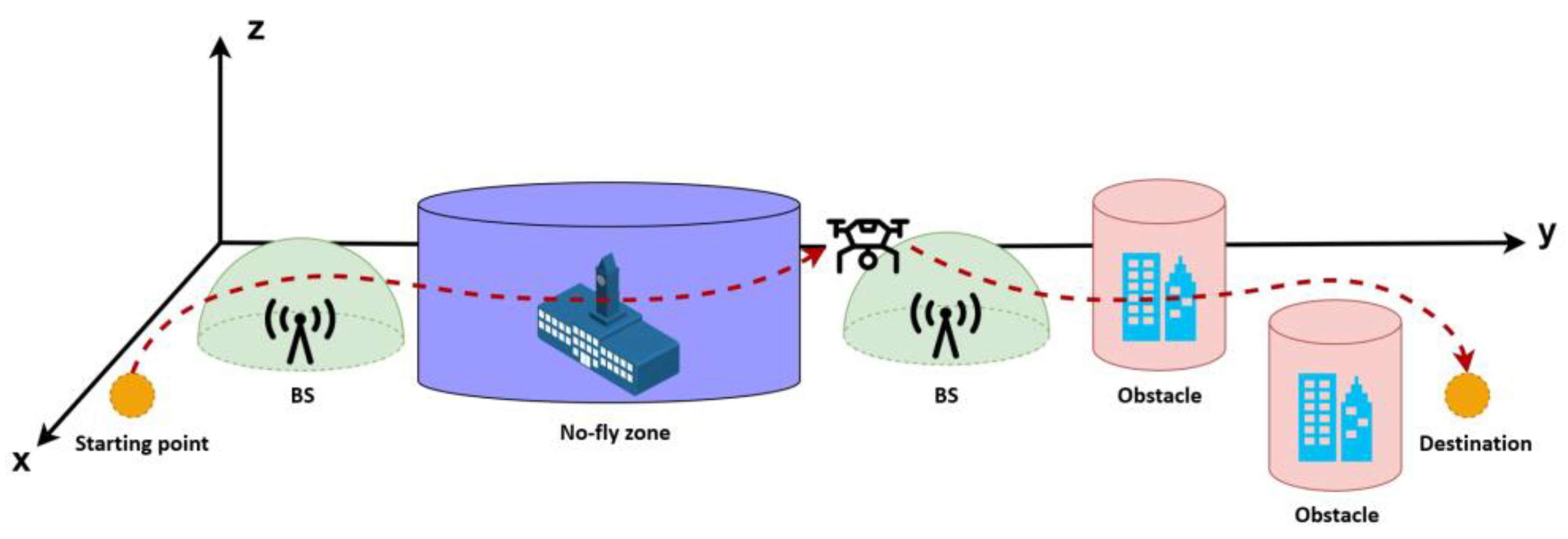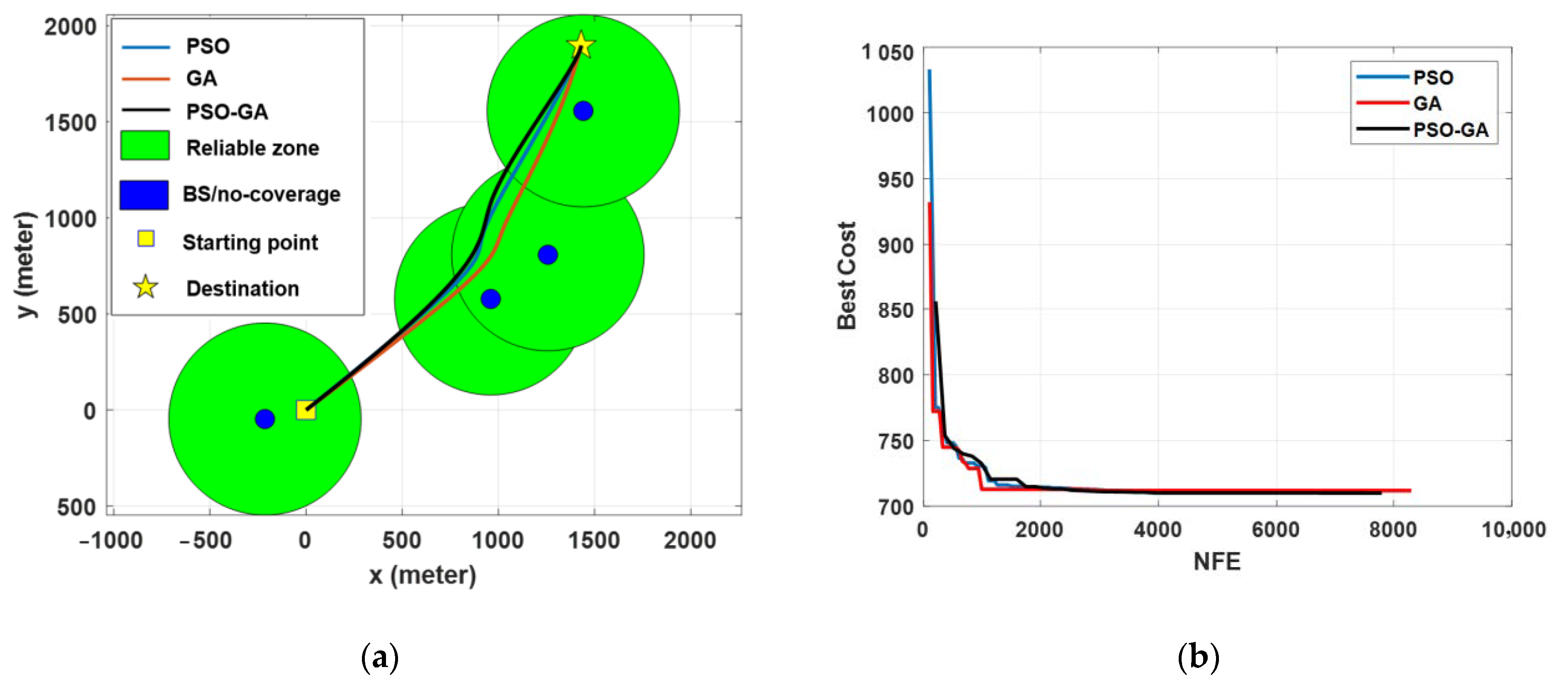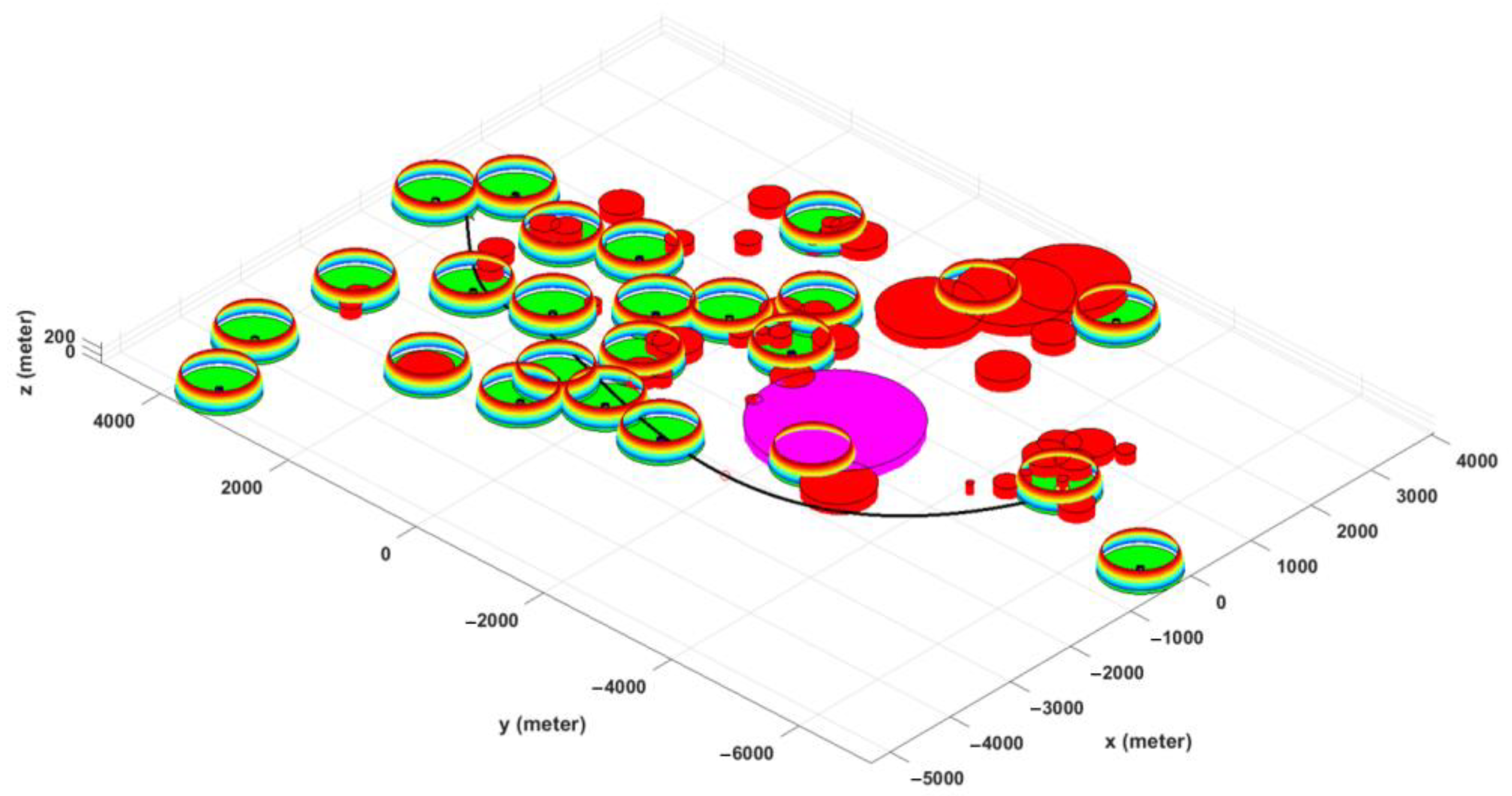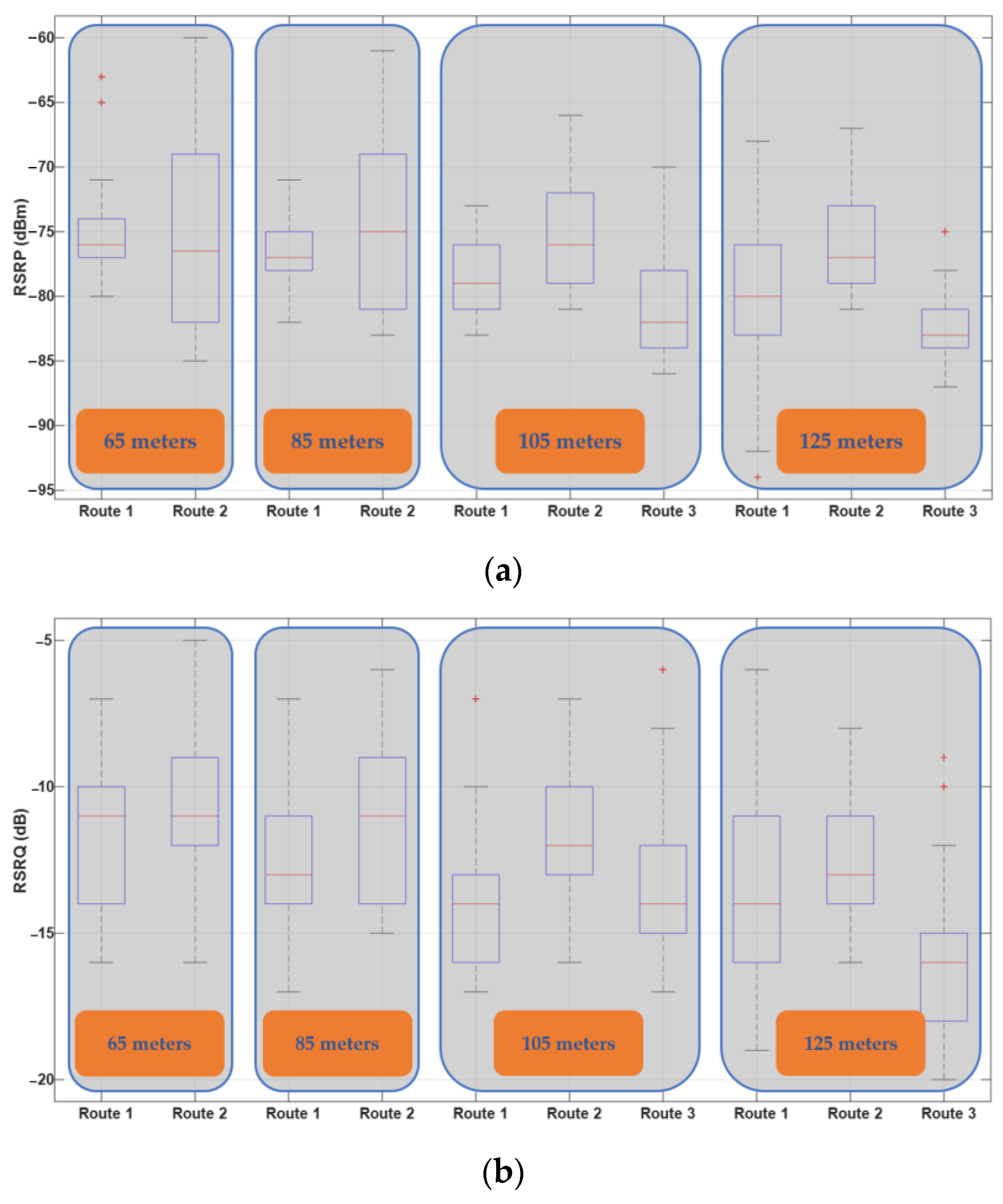This section first discusses the results of a reliable aerial cellular communication zone based on the 4G dataset. Next, the UAV path planning optimization simulation results are presented and discussed. Finally, to validate the ability of the proposed strategy to solve 3D UAV path planning problems, the simulation results of Scenario I are compared with the results of the conducted aerial drive test.
4.1. Reliable Aerial Cellular Coverage
The dataset contains 8457 samples of the data of four BSs on the UKM campus, in which RSRP and RSRQ values were measured along different flight paths and heights. In the following, to demonstrate the status of a signal based on its RSRP and RSRQ level, we refer to the classifications presented in
Table 6.
Figure 5 depicts the box plots of distance, angle, RSRP, and RSRQ for overall data as well as four considered BSs (the overall data are a combination of data from all the considered BSs). The results show that the samples are primarily located in a radius of 10 to 593 m and an angle of 0.5 to 56 degrees. The distribution of the measured data is predominantly influenced by parameters, such as network density, network design, the radiation pattern of antennas, and handover. Results in
Figure 5c,d show that the received signals are in a wide range of strength and quality, from “excellent” to “weak”.
A closer look into the results of different cells reveals that, within the considered radius and elevation angle, the RSRP values between the first and third quartile are almost in “good” status. Meanwhile, RSRQ shows more variations in the considered scenarios and varies from the “good” to the “medium” range.
For a more detailed analysis,
Figure 6 shows box plots of RSRP and RSRQ for Route I at different flight heights. The results show that increasing flight height decreases the median values of RSRP and RSRQ. In the conducted measurement, the drone was flying mostly in the LOS of BSs. Hence, the main factors of RSRP degradation are path loss and antenna gain reduction. The main reason for the antenna gain reduction is that the BS antennas are down-tilted; thus, based on the antenna radiation pattern, by increasing the flight height, the chance of serving the drone with the main lobe decreases. This consequently degrades the received signal energy at the drone side and enhances the uncertainty in the communication link.
On the other hand, RSRQ indicates the received signal quality in a network as well as the effect of interference from adjacent BSs. As the results in
Figure 6b show, in higher altitudes, the drone considerably experiences lower link quality. The main reason is that, besides the desired signal power level degradation, in higher altitudes, drones can see a larger number of BSs. Therefore, the probability of receiving signals from adjacent/interfering BSs increases, and consequently, the drone receives higher interference energy at higher altitudes.
Another parameter that impacts the reliability of a cellular communication link is handover. Handover is considered a required procedure in cellular communications to maintain the connectivity and quality of a link between users and the network. However, the multiplicity of handovers in a short time interval shows the uncertainty of the communication link in an area.
Table 7 demonstrates the impact of flight height on the number of handovers. Note that there was no continuous coverage for Route I at a height of 125 m, that is, the BSs could not provide aerial coverage for the entire path at that height. Therefore, the number of handovers was reduced. As can be seen, the number of handovers in the three routes increased significantly as the flight height increased.
Figure 7 illustrates a two-dimensional representation of RSRP and RSRQ around a 4G BS, based on the RSRP and RSRQ prediction model in [
51], Equations (14) and (15). Note that the utilized equations were developed based on the same dataset used in this study. The results show how RSRP and RSRQ degrade by increasing distance and flight height. In addition, based on the results and radiation pattern of directional antennas, in a radius of roughly less than 50 m, the main lobe is not able to provide sufficient coverage, especially at altitudes above the antenna height.
In conclusion, the results show that for a flight height up to 85 m above ground level (AGL) and a 2D distance up to 500 m, the considered parameters, RSRP, RSRQ, and handover, are primarily in a reliable range, where a BS can provide RSRP and RSRQ better than −80 dBm and −14 dB, respectively. Therefore, it is expected that the existing 4G network can provide a good link for telemetry communications for drones within a 2D distance between 50 to 500 m and heights up to 85 m AGL in suburban areas, where the heights of buildings, trees, and other obstacles are almost lower than the heights of BSs.
4.2. Path Planning Optimization
The positions of the starting point, destination, BSs, obstacles, and no-fly zones were utilized as the inputs, and PSO, GA, and PSO-GA algorithms were employed to solve the problem. Note that the presented figures in this subsection are examples of simulation results selected based on the corresponding mean values, as described earlier in the methodology,
Section 3.4. A detail of the statistical results of the simulations is presented in
Appendix A Table A1. In addition, to better visualize the results, the path planning results are depicted in a 2D form, a horizontal projection of the 3D path planning on
plane, and only an example of 3D simulation results of UAV path planning is presented for Scenario III.
Figure 8 presents the path planning optimization simulation results for Scenario I under different algorithms. Obviously, for an obstacle-free path, the shortest path between the starting point and destination is the direct path. However, as seen from the figure, the optimal paths pass through the reliable zones, while making a tradeoff between minimizing the traveling distance and maximizing the link reliability. By comparing the results in
Figure 8a, it can be seen that PSO-GA provides a slightly better solution, in which the path is shorter while passing from the reliable zone. Results in
Figure 8b show a comparison of the convergence rate of different algorithms. In a small-scale environment, the convergence speeds of all three algorithms are almost the same.
Figure 9 shows the statistical results of path length, reliable path length, and reliable path ratio of the considered algorithms for Scenario I. The wider the data distribution (both interquartile range and whiskers), the lower the stability of the algorithms to solve the problem. In addition, a comparison between median values shows that in small-scale environments, PSO and PSO-GA algorithms slightly outperform GA in providing effective solutions for the considered problem. However, due to the simplicity of the problem in Scenario I and the distinctive features of the utilized algorithm, it can be concluded that all considered algorithms offer effective solutions for this problem.
Figure 10 presents the result of the path planning optimization in Scenario II, which corresponds to a long-range BVLOS scenario. The results show better path planning results of the PSO-GA algorithm compared with PSO and GA due to the higher exploration and exploitation capability of the PSO-GA algorithm for searching the entire search space and, consequently, do not trap in the local optimal and better converge to the global optimal. Results also show some of the shortcomings of the PSO and GA algorithms to minimize the cost function and get trapped in local minima. For example, although the designed path by GA provides a shorter path compared with the other two algorithms, for about 4 kilometers, it passes from an area without cellular coverage. In contrast, PSO-GA effectively computes a path with the most reliable coverage while also minimizing the traveling path. The results of
Figure 10b show that PSO-GA also surpasses PSO and GA algorithms in terms of convergence speed.
Figure 11 compares the statistical results of the path length, reliable path length, and reliable path ratio of 50 simulation experiments on three algorithms in Scenario II. It should be noted that by increasing the environmental scale and enhancing the number of objects, such as BSs and obstacles, the multimodality of the problem will increase, in which the complexity of finding a global optimal for the problem will be increased as well.
Based on the interquartile range of presented box plots, the instability of PSO in optimizing a large-scale path planning problem is obvious. The generated paths vary from straight lines to curvy paths, such as the designed paths by GA and PSO-GA in
Figure 10a, respectively. One of the reasons for this behavior is the feature of information flow in the PSO algorithm, which helps the algorithm to explore the search space better. Meanwhile, during the optimization procedure, due to the inertia, cognitive, and social acceleration coefficient adjustments, the exploration rate gradually decreases, and the exploitation rate gradually increases. This sometimes results in premature convergence, and the algorithm gets trapped in local minima.
On the other hand, although GA provides concentrated results, which look stable, it should be noted that in most simulation experiments, the algorithms converge to a local minimum and is not capable of effectively making a tradeoff between objectives, minimizing the traveling distance and maximizing the link reliability. Among all algorithms, PSO-GA provides stable solutions with a slightly better reliable path length and reliable path ratio.
Scenario III was developed based on a set of real-world constraints, such as the locations of BSs (in this case, the cellular network design in suburban environments), obstacles, and a no-fly zone. The added constraints considerably enhanced the complexity of the problem as well as its multimodality. Simulation results in
Figure 12 show that all three algorithms are capable of computing acceptable paths for the considered problem. However, with the same justification as Scenario II, the PSO-GA algorithm still surpasses the other two algorithms in terms of generating a smoother path and faster convergence speed.
Figure 13 depicts a 3D map of the UAV path planning with the PSO-GA algorithm for Scenario III, and
Figure 14 depicts an overlay of the horizontal projection of the 3D path planning on the Google map of the considered environment. As can be seen from the figures, PSO finds a valid path while effectively avoiding obstacles and the no-fly zone and maximizing the reliable path length.
Figure 15 compares the statistical results of the path length, reliable path length, and reliable path ratio of the three algorithms in Scenario III. By comparing the results of
Figure 15a, it can be seen that the median values of all three algorithms are almost the same. However, PSO-GA surpasses the other two algorithms due to the shorter uppers and lower whiskers, as well as the closeness of the median value to the minimum computed path length. The results comparison also reveals the lower stability of PSO compared with GA and PSO-GA. By comparing the results of Scenarios II and III, it can be seen that in Scenario III, the performance of the algorithms is more similar compared with Scenario II. That is because by adding more constraints to the problem, the search space becomes more restricted, which limits algorithms’ instability in generating more diverse solutions.
As previously mentioned, enlarging the scale of the problem and increasing the number of objects in a problem will increase the complexity of the problem.
Figure 16 presents the results of the average execution time of three algorithms in different scenarios. As can be seen, the execution time of PSO and GA algorithms is almost the same, while PSO-GA executes far faster than the other two algorithms, about two times in complex scenarios. This superior performance becomes even more critical when the algorithms run on low-power computing devices, such as onboard processors or embedded systems.
4.3. Results Validation
To validate the ability of the proposed strategy to solve the 3D UAV path planning problems, this subsection compares the simulation results of Scenario I with the results of the conducted aerial drive test on the UKM campus.
Figure 17 and
Figure 18 indicate the RSRP and RSRQ values for different routes and heights. The change of the color spectrum from cold to warm indicates the improvement of the RSRP and the weakening of the RSRQ. The result comparison reveals a better aerial coverage on Route II in terms of RSRP and RSRQ. Additionally, by comparing the results of Route II with the BSs’ locations in
Figure 3, it can be revealed that the UAV is served with better RSRP and RSRQ values when it is inside the proposed reliable zone.
Figure 19 summarizes the RSRP and RSRQ measurement results for different routes and heights in the form of box plots. As can be seen, by increasing the flight height, the mean values of both RSRP and RSRQ degrade. On the other hand, Route III provides the worst result, since throughout the flight mission, the distance between the UAV and BSs is greater compared with Routes I and II. Based on the minimum, maximum, and mean values of presented results as well as their distribution, Route II with flight heights of 65 and 85 m provides the best RSRP and RSRQ results.
Finally,
Figure 20 projects the results of the optimized flight path (computed by the PSO-GA algorithm) on the results of the three measured routes (at a height of 85 m). The results reveal that the computed optimal path is close to Route II, and the proposed strategy can effectively solve the UAV path planning problem in real-world scenarios.
Generally, the results show that the PSO-GA algorithm can provide the best solution for the 3D UAV path planning problem among all three algorithms. PSO-GA has the best performance in terms of generating feasible solutions, reliable path length, reliable path ratio, convergence speed, and execution time. In addition, PSO-GA outperforms the other two algorithms in terms of searching ability and stability. The comparison of simulation and measurement results also validates the effectiveness and feasibility of the proposed solution in a suburban environment.




























